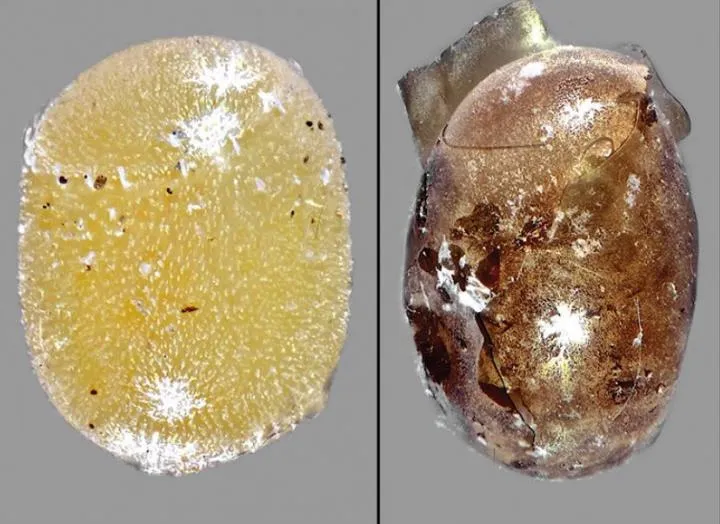Tiny Parasitic Wasp Named After Idris Elba Hijacks Stink Bug Eggs
The wasp genus Idris had only been known to infest spider eggs, until now
/https://tf-cmsv2-smithsonianmag-media.s3.amazonaws.com/filer/fb/29/fb2959ed-73a7-49fb-8b56-3bf6274e35a6/217030_web.jpg)
With more than 300 species and counting, the genus Idris is a particularly widespread variety of parasitic wasp. The tiny insects, usually no bigger than the tip of a pencil, are known to hijack spider eggs for their larvae’s sustenance and development. But because of their small size and distribution across the planet, many species of Idris remain unknown to science.
Elijah Talamas, a taxonomist at the Florida State Collection of Arthropods, once joked to a colleague after seeing an ad for a movie with a certain British movie star, “Someone has just got to name a species Idris elba.” But he never expected to have the opportunity to name an Idris specimen himself. The wasps he studies typically parasitize stink bug eggs, and all known species of Idris infested arachnoid hosts.
Meanwhile, in a lab in Guanajuato, Mexico, four parasitoid wasps crawled out of the eggs of an invasive species of stink bug named Bagrada hilaris. Also known as the bagrada bug, this stink bug was first sighted in Guanajuato in 2017. The voracious pest mainly feeds on cruciferous vegetables, such as cauliflower and brussels sprouts, a diet that could have devastating consequences in a region responsible for 70 percent of Mexico’s broccoli production. So a team of entomologists led by Refugio Lomeli-Flores set out to conduct a survey of natural enemies of the bagrada bug, collecting its eggs in fields throughout Guanajuato to watch for signs of parasitism.
The parasitoid that emerged from the bagrada eggs looked like it might belong to the Idris genus, so Lomeli-Flores sent photos of it to Talamas for confirmation. Talamas was skeptical, but curious. “Idris is a gigantic genus found worldwide, and all of the host records are from spiders,” he says. “Of course, I didn't want to write back and say, ‘I don't believe it.’ Because maybe they were right.”
Lomeli-Flores kept each egg in its own petri dish, so the wasps had to have emerged from the bagrada bug eggs. Even given the evidence, Talamas says, people who study parasitoid wasps would find this discovery unthinkable.
“There’s nothing unusual, morphologically. But the choice of the host is absolutely baffling,” says Lubomir Masner, a parasitic wasp expert. “The whole genus belongs to a group that is absolutely constant in choice of hosts, and all of a sudden … we have a very first case where a member of this genus is attacking hosts other than spiders.”

In search of definitive proof, Talamas turned to molecular forensics. He recruited his colleague Tara Gariepy, a research scientist at Agriculture and Agri-Food Canada, to compare the DNA of the adult wasps to residual DNA left in the stink bug egg shells. It was a match: the Idris wasps parasitized a non-spider host.
After triple-checking the evidence, the last thing Talamas had left to do was give the trailblazing wasp a name. He called it Idris elba. “It was too funny not to do it,” he says.
The research team published a formal description of Idris elba in the Journal of Hymenoptera Research on Monday. In the study, they consider potential explanations for the wasp’s unusual host choice. Perhaps the Idris genus is more of a generalist than scientists thought, or this particular species may have stumbled upon bagrada bug eggs by chance. Unlike most stink bugs, the bagrada bug lays its eggs in soil—as do some spiders. Idris elba could have gotten the eggs confused, especially if they share a similar chemical signature with spider eggs.
Another possibility is that Idris elba shifted its focus to a different insect host. “This kind of thing happens all the time in evolution,” Talamas says. “In fact, we know that this has occurred, because that's how parasitoids came to be so diverse. They can shift from one host to another.” However, it’s rare to see an evolutionary transition take place over such a short time span.
If Idris elba continues to attack bagrada bug eggs, the tiny wasp has the potential to solve a very expensive problem plaguing North American agriculture. The bug caused an estimated $679 million in damages in California in 2013 alone, and it could have a similarly destructive effect in Mexico.
Charlie Pickett, an environmental scientist working with the California Department of Food and Agriculture, says parasitoids that prey on pests can offer an alternative to pesticides. However, he hasn’t found any parasitoids that preferentially attack bagrada bug. “Generalist predators and parasitoids are great to have around and they do play a role, but typically, if you don't have something part of that mix that specializes on whatever the target organism is, you're going to have a problem,” he says.
Researchers don’t know the extent to which Idris elba parasitizes bagrada bug eggs. Talamas says there are at least four other species of parasitoid wasp—outside of the Idris genus—that prey on the bagrada bug, so it’s difficult to measure Idris elba’s impact on the population. “We're fairly certain that parasitoids are having an effect,” he says. “It's just difficult to measure that effect and to attribute it to the wasps, as opposed to something like climate or disease.”
/https://tf-cmsv2-smithsonianmag-media.s3.amazonaws.com/accounts/headshot/Daily-Staff-Photos-by-Noah-Frick-Alofs-3620-317x475.jpg)
/https://tf-cmsv2-smithsonianmag-media.s3.amazonaws.com/accounts/headshot/Daily-Staff-Photos-by-Noah-Frick-Alofs-3620-317x475.jpg)